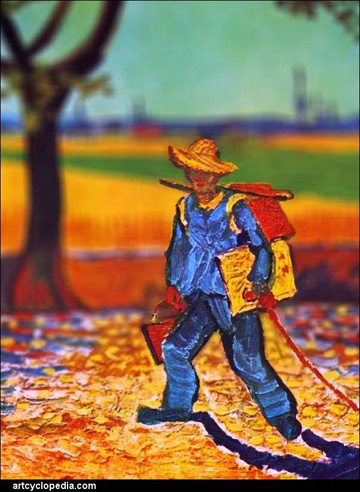Over at the Artcyclopedia, edited by John Malyon, a new slideshow has appeared, showcasing versions of 12 paintings by Dutch post-impressionist painter Vincent Van Gogh which have been digitally manipulated to look like photos of three-dimensional models.
In tilt-shift photography, a special lens is used which lends the illusion that a photo is of a miniature model (Artcyclopedia has some stunning examples of the technique). For this Van Gogh gallery, Photoshop was used to simulate the effects of this tift-shift method, by adjusting the contrast, saturation, and depth of focus of some of the artist’s most famous paintings. The results can be startling, as in this version of Van Gogh’s 1888 painting, “The Painter on His Way to Work”:
(click here to see the original)
*
Van Gogh’s art is studied in the second-year Core Humanities, and often provide Core students with stimulating paper topics. He was, after all, quite an interesting figure; once, he claimed that he wanted to create an image that could make the viewer go mad: his “Night Café” was the result. He lived his life believing himself to be a failure, unaware of the fame he would receive after death.
Annalisa Dias-Mandoly (Core ’08, CAS ’10), was inspired by Van Gogh’s “Starry Night” to write the following poem, which appeared in the Core Journal in Spring 2008:
STARRY NIGHT
Let me live in a cave for all my life.
Shimmering starlight blinds my eyes
And, in agony, I try to turn away,
But everywhere radiance remains.
I would rather be comfortable and safe.
So let me live in a cave and outlast the day.
I accept your shackles with heartfelt thanks.
They take the fault off my back.
Yes, let me keep my back to the world-
Watching shadows dance along in silence,
I will write their stories with my dry wit.
Here again, as always, I and we and
All those sad and sorry ones sleep
Away the light, straining in the night
To see past reflected starbeams.
*
Did you know? There is an entire website devoted to the personal letters Van Gogh sent to his brother Theo.

